Jukebox
A jukebox is a partially automated music-playing device, usually a coin-operated machine, that plays a patron's selection from self-contained media. The classic jukebox has buttons with letters and numbers on them, which are used to select specific records. Some may use compact discs instead. Disc changers are similar devices for home use; they are small enough to fit on a shelf and can hold up to hundreds of discs, allowing them to be easily removed, replaced, or inserted by the user.

(1971)
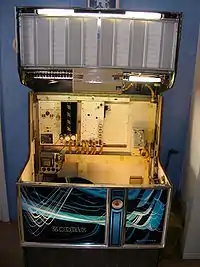
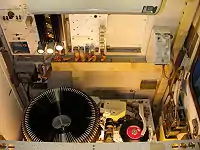
History
Coin-operated music boxes and player pianos were the first forms of automated coin-operated musical devices. These devices used paper rolls, metal disks, or metal cylinders to play a musical selection on an actual instrument, or on several actual instruments, enclosed within the device.
In the 1890s, these devices were joined by machines which used recordings instead of actual physical instruments.[1][2]
In 1889, Louis Glass and William S. Arnold invented the nickel-in-the-slot phonograph, in San Francisco.[3] This was an Edison Class M Electric Phonograph retrofitted with a device patented under the name of 'Coin Actuated Attachment for Phonograph'. The music was heard via one of four listening tubes.[4]
In 1928, Justus P. Seeburg, who was manufacturing player pianos, combined an electrostatic loudspeaker with a record player that was coin-operated.[5] This 'Audiophone' machine was wide and bulky because it had eight separate turntables mounted on a rotating Ferris wheel-like device, allowing patrons to select from eight different records.
Later versions of the jukebox included Seeburg's Selectophone with 10 turntables mounted vertically on a spindle. By maneuvering the tone arm up and down, the customer could select from 10 different records.[4]
The word "jukebox" came into use in the United States beginning in 1940, apparently derived from the familiar usage "juke joint", derived from the Gullah word juke, which means "bawdy".[6] Manufacturers of jukeboxes tried to avoid using the term, associated with unreputable places, for many years.[7]
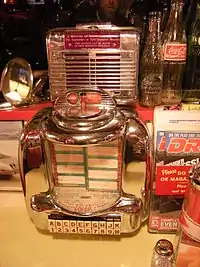
Wallboxes were an important, and profitable, part of any jukebox installation. Serving as a remote control, they enabled patrons to select tunes from their table or booth. One example is the Seeburg 3W1, introduced in 1949 as companion to the 100-selection Model M100A jukebox. Stereo sound became popular in the early 1960s, and wallboxes of the era were designed with built-in speakers to provide patrons a sample of this latest technology.
Jukeboxes were most popular from the 1940s through the mid-1960s, particularly during the 1950s. By the middle of the 1940s, three-quarters of the records produced in America went into jukeboxes.[8] Billboard published a record chart measuring jukebox play during the 1950s, which briefly became a component of the Hot 100; by 1959, the jukebox's popularity had waned to the point where Billboard ceased publishing the chart and stopped collecting jukebox play data.[9]
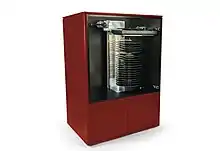
As of 2016, at least two companies still manufacture classically styled jukeboxes: Rockola, based in California, and Sound Leisure, based in Leeds in the UK. Both companies manufacture jukeboxes based on a CD playing mechanism. However, in April 2016, Sound Leisure showed a prototype of a "Vinyl Rocket" at the UK Classic Car Show. It stated that it would start production of the 140 7" vinyl selector (70 records) in summer of the same year.[10][11]
Since 2018, Orphéau, based in Brittany in France manufactures the original styled "Sunflower" Jukebox with the first 12" vinyl record selector (20 records), on both sides.[12]
Notable models
- 1927 LINK – Valued at US$40,000 and extremely rare[4]
- 1940 Gabel Kuro – 78 rpm, the manufacturer's last model. Four or five are known to exist; valued at US$125,000[4]
- 1942 Rock-Ola President – Only one is known to exist; valued at least US$150,000[4]
- 1942 Rock-Ola Premier – 15 known to exist; valued at US$20,000[4]
- 1942 Wurlitzer 950 – 75–90 known to exist; valued at US$35,000[4]
- 1946 Wurlitzer Model 1015[13] – Called the "1015 bubbler", it offered 24 selections. More than 56,000 were sold in less than two years. Considered a pop culture icon, it was designed by Paul Fuller.[4]
- 1952 Seeburg M100C – The jukebox exterior used in the credit sequences for Happy Days in seasons 1–10. It played up to fifty 45-RPM records, making it a 100-play. It was very colorful, with chrome glass tubes on the front, mirrors in the display, and rotating animation in the pilasters.[4]
- 1967 Rock-Ola 434 Concerto – The jukebox interior used in the credit sequence for the 11th and final season of Happy Days. Like the Seeburg M100C, it played up to fifty 45-RPM records, but unlike the M100C, had a horizontal playback mechanism.[4]
- 2018 Orphéau Sunflower Serie – The first jukebox that played up to twenty 33-RPM records on both sides, using automation technology.[14]
Decline
Traditional jukeboxes once were an important source of income for record publishers. Jukeboxes received the newest recordings first. They became an important market-testing device for new music, since they tallied the number of plays for each title. They let listeners control the music outside of their home, before audio technology became portable. They played music on demand without commercials. They also offered high fidelity listening before home high fidelity equipment became affordable.[4]
In 1995, the United States Postal Service issued a 25-cent stamp commemorating the jukebox.[15]
Modern derivatives
Jukebox digital music players
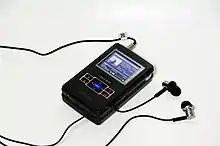
The term "jukebox" was used to describe high-capacity, hard disk based digital audio players due to their amount of digital space allowing a great number of music to be stored and played.[16][17] The term was popularised following the introduction of the Creative NOMAD Jukebox in 2000, which could store as many as 150 CDs of music on its six gigabyte hard drive.[18] In later years, the "classic" iPod would become the most popular product in this category.[16]
Digital jukebox and apps
While the number of traditional jukeboxes declined, digital jukeboxes, also called "social jukebox", have been introduced.[19]
See also
References
- Athitakis, Mark (1 December 1999). "Riff Raff: Jukebox hero and Gordon Dorsey". SF Weekly. Archived from the original on 21 February 2015. Retrieved 28 May 2009.
- Great Geek Manual – Glass/Arnold patents
- "How the Era of the Jukebox Came and Went".
- Weiss, Brett (15 October 2010). "Rock on with vintage jukeboxes". Antique Week.
- Carlisle, Rodney (2004). Scientific American Inventions and Discoveries. Hoboken, NJ: Wiley. ISBN 0-471-24410-4.
- "Juke house". Dictionary.com. Archived from the original on 30 March 2016. Retrieved 18 April 2022.
- Elijah Wald (3 August 2010). The Blues: A Very Short Introduction. Oxford University Press. p. 43. ISBN 978-0-19-975079-5. OCLC 1014220088.
- Cowen, Tyler (2000). In Praise of Commercial Culture. Harvard University Press. pp. 164, 166. ISBN 0-674-00188-5.
- Molanphy, Chris (1 August 2013). "How The Hot 100 Became America's Hit Barometer". All Things Considered. NPR. Retrieved 14 March 2018.
- Miller, Norman (11 May 2016). "Why fans of vintage vinyl love this brand-new machine". BBC Capital.
- "Classic Jukeboxes". SoundLeisure.
- "Matthieu Defoly invente le jukebox nouvelle génération – Le Journal des Entreprises – Ille-et-Vilaine". Le Journal des Entreprises (in French). Retrieved 18 November 2020.
- "Wurlitzer 1015". Picollecta. Archived from the original on 14 January 2015. Retrieved 14 January 2015.
- Durox, Par Solenne; à 11h55, correspondante en BretagneLe 24 décembre 2019 (24 December 2019). "Bretagne : le jukebox remis au goût du jour par un Rennais". leparisien.fr (in French). Retrieved 18 November 2020.
- "Stamp Series". United States Postal Service. Archived from the original on 10 August 2013. Retrieved 2 September 2013.
- "The iPod wars". TheGuardian.com. November 2003.
- Biersdorfer, J. d. (19 June 2003). "NEWS WATCH: PORTABLE AUDIO; Music Lasts Longer on a Hybrid Player". The New York Times.
- "New Nomad Jukebox Digital Music Player Really Turns up the Volume". Los Angeles Times. 14 September 2000.
- France, Jasmine. "Create jukebox playlists before hitting the town". cnet. Retrieved 3 August 2016.
External links
 Media related to Jukeboxes at Wikimedia Commons
Media related to Jukeboxes at Wikimedia Commons